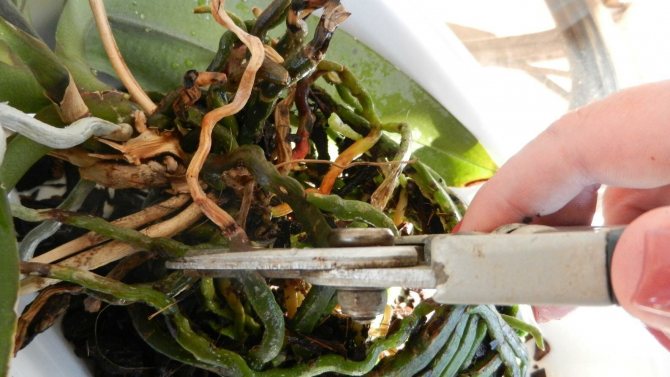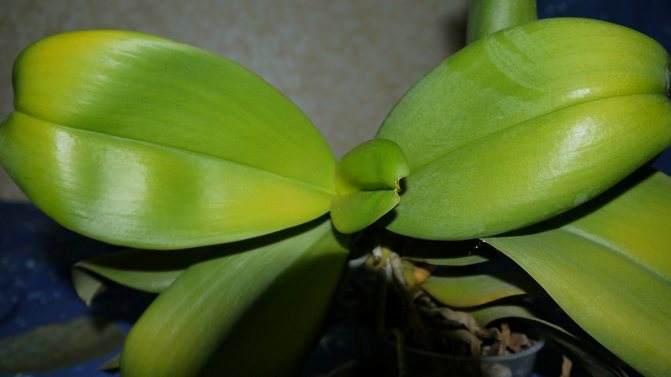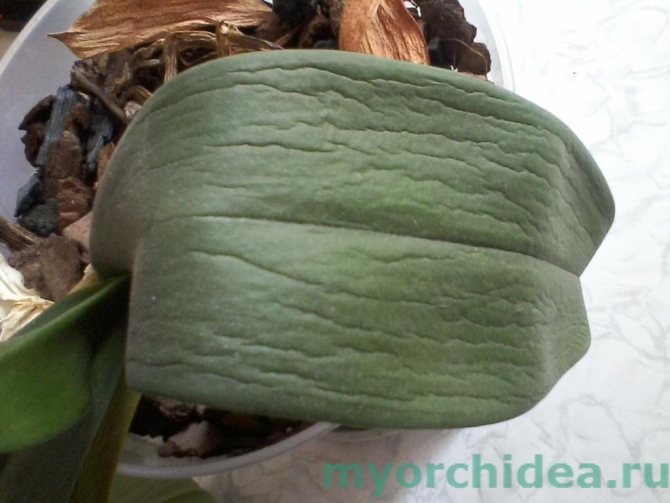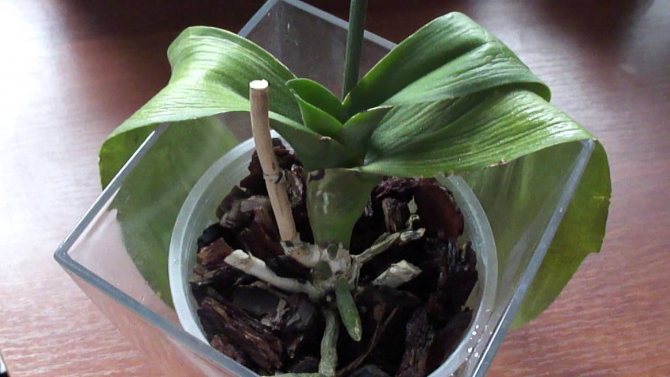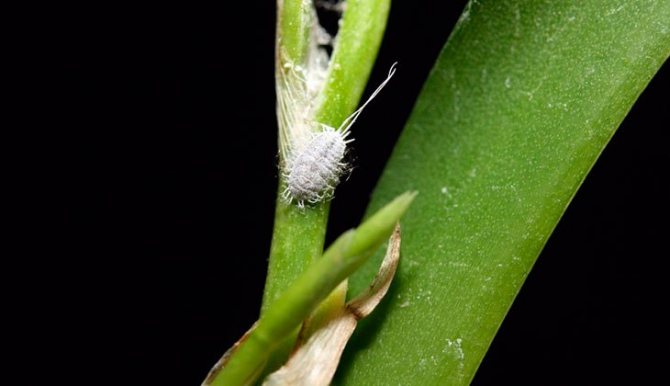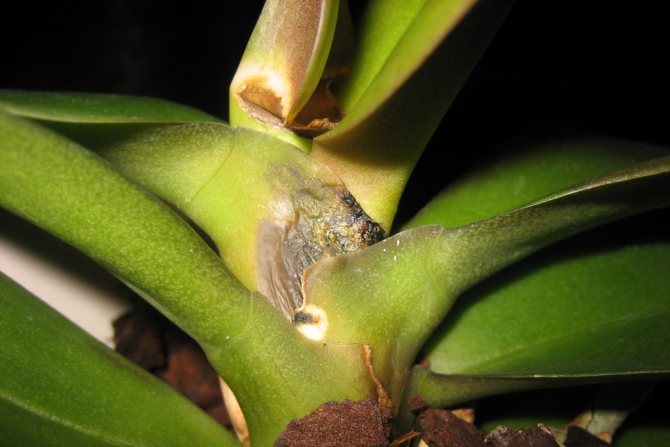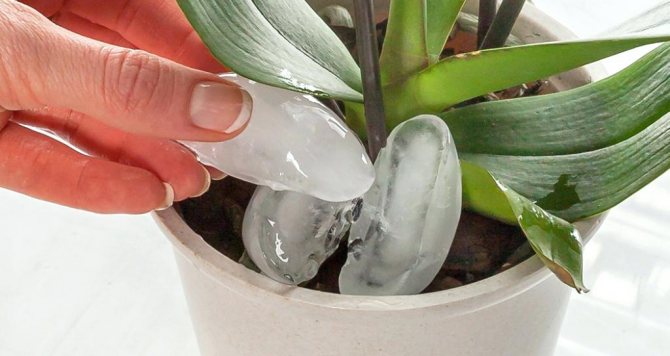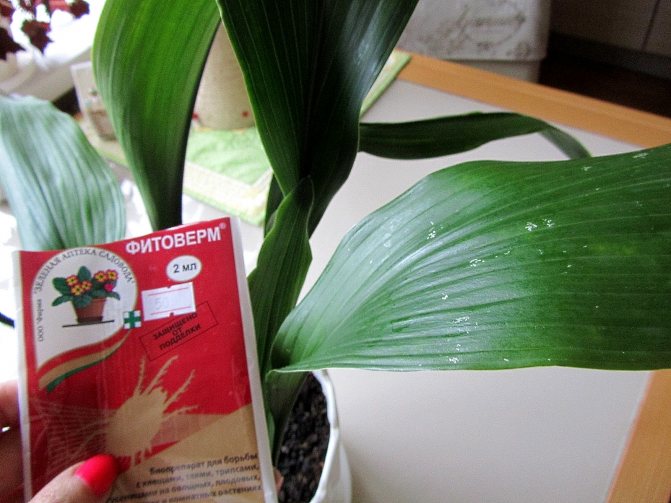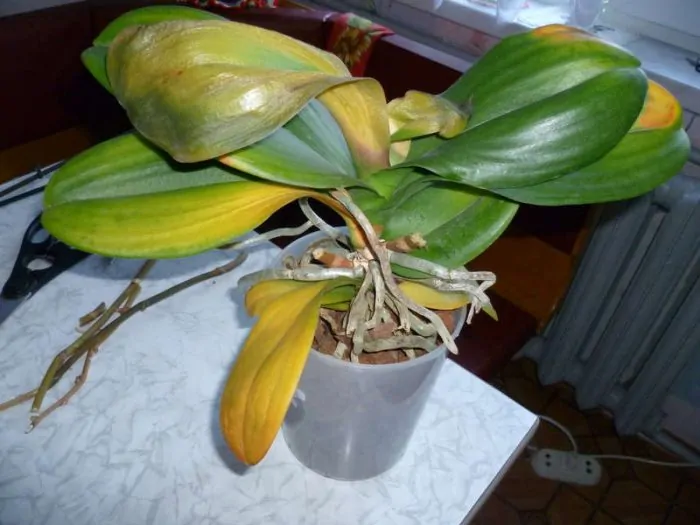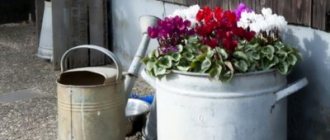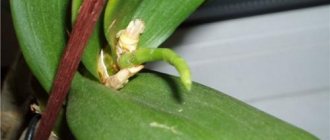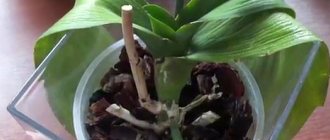What does a withered flower look like?
Sometimes the plant acquires a yellow, brown tint, its leaves begin to wrinkle, and the buds begin to fall off.... In some cases, sticky discharge may appear to these symptoms. The leaves become corrugated, the flowers are small and rare. In advanced cases, tears, specks and spots can be observed on the leaves.
Important: If you do not establish the cause of the trouble and save the orchid, it may die.
Why do orchids need a peduncle
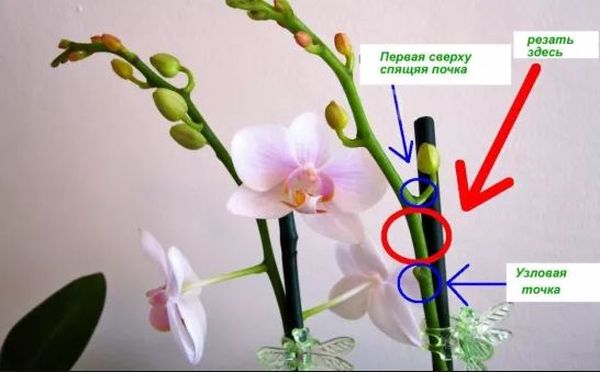
The peduncle in orchids appears after a dormant period, when the plant has gained new strength and is ready to knock out the buds. Over time, flowers form on the peduncle, which will delight you for more than one month. But all good things come to an end someday, including the flowering period of the orchid. Over time, the flowers wither and crumble, and it turns out that the main function of the peduncle has already been completed.
However, do not rush and immediately cut the arrow - if it does not turn yellow, it is quite possible that you can "make" it bloom again. If the peduncle begins to dry out from above, the dead part can be safely removed, stepping back from the first living bud a few centimeters.
Another scenario is possible: from a living bud on the peduncle, small leaves, the so-called babies, appear. After a while, a full-fledged small plant will appear on the arrow, which can be planted in a separate pot.
Why is this happening?
The withering of a fragile flower can begin for several reasons.:
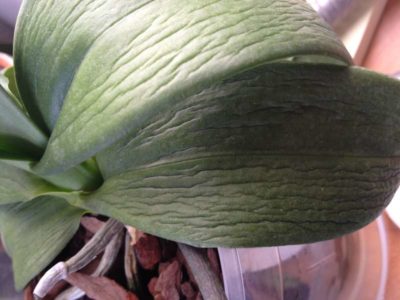

The first thing that comes to our mind when we see a wilting orchid is that it needs more water. However, this is not always the case. If only the lower leaves of phalaenopsis wither, this means that, having given all the nutrients to the upper "brothers", it will soon dry out. This is a healthy, normal process that requires no intervention.- Too cramped pot, where the root system of the orchid is unnecessarily pinched.
- If the irrigation regime has been violated and the orchid has long been "thirsty" for the direct rays of the sun. Dry air, a room with heating and no humidifier does not help the orchid bloom.
- Decay of roots. Packed in polyethylene and planted in tight pots without holes, orchids from the supermarket are watered abundantly, but excess moisture has nowhere to evaporate.
- Excessive fertilization. The roots of the plant get a kind of "burn".
- Pests: aphids, scale insects, spider mites and others.
- Ethylene gas from heaters that use propane or kerosene for fuel can poison orchid buds! Paint fumes and tobacco smoke are also not conducive to a healthy atmosphere.
Is it possible to fix the situation
The measures to save the culture will directly depend on the factor that caused the flowers to fall. If the reason is in the wrong neighborhood, you should rearrange the plant pot or remove the negative factor. When it comes to dry air, you should place containers of water nearby or spray the orchid from a spray bottle from time to time. In case of overheating, you need to immediately remove the plant to a safe place, and in the future to prevent such situations. As for pests, they need to be dealt with promptly and mercilessly.
Follow these simple rules, and your orchid will delight you with lush exotic flowers for a long time.
How can you determine a more precise cause?
If only the lower leaves dry, there is no cause for concern. They should be removed after complete drying. The following problems arise with improper care:
- Both the lower and upper leaves dry out - the usual watering regime was violated. If an orchid “lives” in excessively dry air, its leaves are not sprinkled with water or rubbed with a sponge, it “weaned” to absorb water evenly. The root system dries up and the plant does not receive the substances and water necessary for growth.
- Leaves do not absorb water, but at the same time lethargic, like a rag. In this case, the problem is also in the roots, but in this case they have rotted due to excessive watering.
Having learned the source of problems of this kind, it is easy to "revive" the orchid, but with diseases the situation is somewhat different:
- The plant receives the required amount of water and light, but has withered leaves, and the petals turn brown. It is necessary to establish how and in what quantities fertilizers were introduced into the soil. If the fertilizer is not washed out with water, salt build-up and root burn can destroy such a delicate flower.
- Do the leaves have dark tubercles, become sticky, become overgrown with "cobwebs" and holes form on them, as if someone burned a cigarette in them? The work of small pests is evident.
How to save a plant?
So, first the general rules:
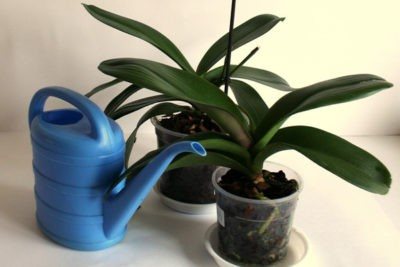

Transfer... An orchid purchased from a store in cellophane and a small vessel should be freed from them and carefully transplanted into a larger pot with holes at the bottom, without damaging the roots. Moss planted in a pot with an orchid will help her revive. Do not transplant the plant during the flowering period!- Watering mode... Water the orchid with cool water every four days. Next, the plant should be watered once a week, but this should be done more often during the initial recovery phase. To avoid root decay, you need to make sure that there are holes at the bottom of the pot through which excess water flows. Leaves should be wiped with a damp cloth or sponge, sprayed with a spray bottle.
What to do if buds suffer?
Correct the temperature. It is better to move the pot with an orchid to a place where too much sunlight does not fall. The ideal daytime temperature is 20 ° C. Orchids should be cool at night, otherwise the buds will wither.
We recommend watching a video about the reasons for the drying of orchid buds:
How to help if the leaves dry and turn yellow?
- You need to start fertilizing a store orchid only 6 months after purchase. It is better to underfeed than overfeed. A plant that has received a nitrogen burn should be stopped fertilizing.
- Root pruning. When transplanting, it is necessary to remove non-functioning, dry or, on the contrary, rotted, damp roots. During this procedure, you need to be especially careful and careful.
If the orchid is "sick" with viral ailments it will have to be thrown away... In other cases, it will help:
- Removal of damaged areas with a sterile knife.
- Treatment with a solution of copper sulfate, charcoal or fungicidal preparations. The "antidote" is selected according to the "diagnosis".
Attention: Affected plant should not be left next to other flowers!
We recommend watching a video about the causes of drying and yellowing of orchid leaves:
What if the flowers wither?
What a pity when the luxurious buds suddenly fall off. There are reasons for everything. The plant is also a living being.
The factors causing these processes are almost the same as during wilting, leaf fall. We will just add something.
Changing your place of residence is not always enjoyable. Orchids are especially hard to tolerate. You bought a gorgeous flowering plant. They brought him home. Then the trouble began.Just moving plus a new place influenced your beauty so much. A different climate, different conditions of detention - enough for the flowers to begin to fall.


- Natural aging
Withering, dropping, dying off is a natural process. There is no eternal bloom. Some delight us with beautiful buds for a week or two. Others last for several months. In addition, it is not known how much phalaenopsis bloomed before you acquired it. Perhaps, when buying, this period was just ending.


- Hypothermia
Orchids are thermophilic. Transporting it in winter is one of the causes of the problem. Even when packed well. At home, the temperature is also less than acceptable. It is set at 22 - 32 degrees. Depends on the periods. Stick to modes. Especially the humidity of the air. The average rate is 70%. Its deficiency also serves as a factor in the dropping of flowers.
- Draft
Orchids need good air circulation. But the draft is destructive. It is enough to thoroughly ventilate the room.
- Food location nearby
Especially vegetables and fruits. Some of them release ethylene. This gas stimulates the ripening of flowers, even unopened buds. Rapid ripening leads to early wilting. Therefore, remove all food from the flower.
- Pollination
During warm periods, the pot is taken out to the open balcony, "to breathe". Small insects pollinate the plant. When everything went well, the wilting flower will replace the seed pod. If not, then it will disappear.
- Pests
Mealybugs are especially damaging. He loves the juice of the buds. Outwardly it looks like cotton wool. Leaves behind a sticky mark.
Prophylaxis
So, prevention includes:
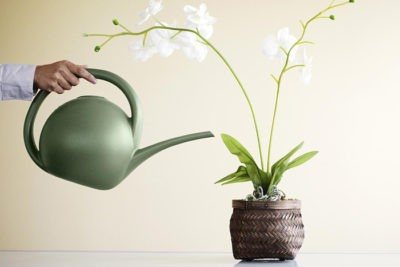

Providing sufficient light for the orchid... In summer, the pot should be no further than 10-15 cm from the window, while direct sunlight should be avoided. The flower receives solar energy from above, not from the sides.- Regular, even watering... Not too much, not too little.
- Optimal temperature conditions... The low temperature, coupled with high humidity, provokes the appearance of rot!
- Pure water... It can be rainwater, distilled water, or water infused with eggshells.
Major mistakes in care
It is not difficult to care for the Phalaenopsis orchid, although many consider it finicky.
A beauty from the tropics is required:
- Abundant watering;
- High air humidity;
- Sufficiently high air temperatures;
- Regular feeding.
But not always and not everyone succeeds in giving the plant what is needed.
There are times when the grower gives too much. It is because of this orchids often:
- Leaves wither;
- Roots rot;
- Peduncles are absent for a long time;
- Flowers and buds fall.
There are many methods of recovery, each of them will be effective only when establishing causes of problems.
Insufficient watering
Most often orchid leaves wither from insufficient watering.
The substrate with the plant just dries up, roots don't get enough moisture and cannot nourish the leaves.
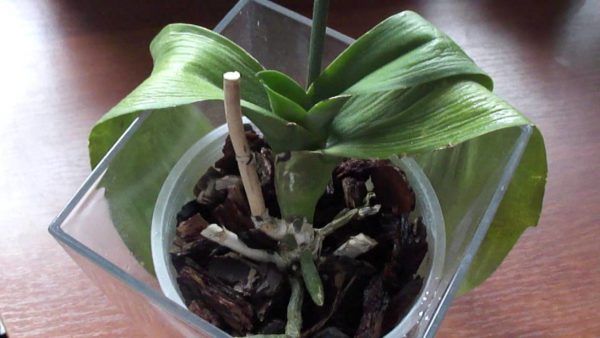

Due to insufficient watering of the orchid, the leaves have withering properties.
Those, in turn, show their dissatisfaction with withering.
To restore the green part of the plant, necessary:
- Normalize watering. To do this, it is worth carefully observing the state of the root system, as soon as it dries out and there will be no condensation on the walls of the pot, it is worthwhile to please the stem with moisture;
- If after a couple of such procedures the leaves do not regain their elasticity, you can apply succinic acid solution... The remedy is renowned for its revitalizing possibilities for indoor plants;
- Will be a good helper and sugar syrup with glucose... You can simply use a phalaenopsis watering agent.But there is another way to use it, sugar syrup is used to treat the leaves of the plant, after drying it forms a dense crust that prevents the leaves from losing moisture. Usually the procedure is carried out at night, and in the morning everything is washed off well and the leaves get wet.
With insufficient watering is effective shower for a plant, while the water temperature is at least 35 degrees.
Excess watering
An excess of moisture will not lead to anything good either, root system phalaenopsis orchids will start to rot, healthy roots will not be able to cover all the costs required for foliage.
Leaf wilting is inevitable.
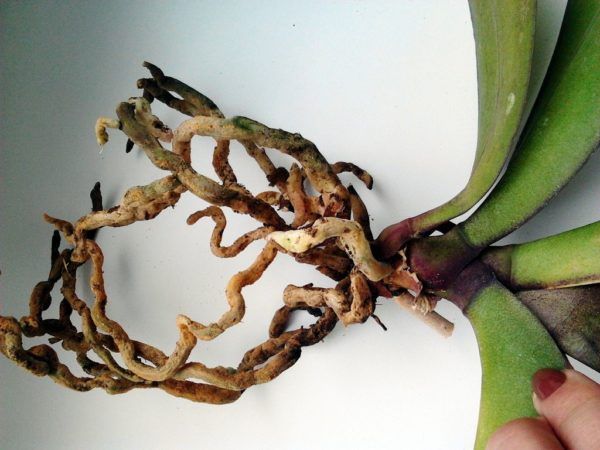

Over-watering your orchid can lead to root rot.
To restore a normal appearance and normalize the "well-being" of the trunk, it is necessary to carry out such work:
- Extract the flower from the substrate, carefully examine the entire root system;
- Remove rotten roots to living tissue, while not forgetting about the processing of the sections;
- Dry the roots for 8-10 hours;
- Prepare a new, drier and looser planting material, and plant a flower in it;
- In the future, you should strictly monitor that there is no waterlogging, otherwise you can completely lose the stem.
Hypothermia
In case the plant was overcooled or even frostbite, rescue operation is carried out in this order:
- Roots are examined... When frozen, they will become soft, such a rhizome must be removed;
- If after removal there is not a single root left, they should be increased, how to do it correctly, we have already told. Fit any of the described methods;
- If some roots managed to survive, it is necessary to help them grow as soon as possible. This will be facilitated moderate watering and regular fertilization.
Dense substrate
The reason for the wilting of the leaves of phalaenopsis can also be the compaction of the soil in which the plant grows and develops. This contributing factors:
- The roots are not ventilated;
- Decay begins;
- Excess moisture does not come off well.
There is only one way to deal with this, it is quite simple change substrate, before that, carefully examining the rhizome for putrefactive blotches.
Overheat
If the flower has been exposed to direct sunlight for a long time or grows on a windowsill, under which there is a very hot battery, overheating cannot be avoided.
Moreover, not only the leaves, but the entire stem will suffer from this.
The plant must be rescued immediately, for this it is immediately necessary rearrange it to partial shade or simply remove from the windowsill.
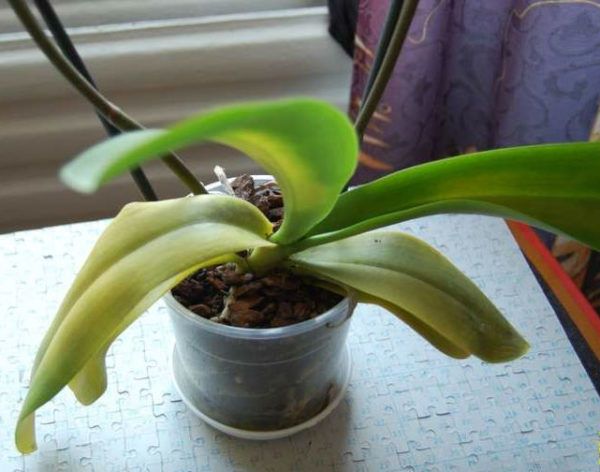

Direct sunlight can cause the plant to overheat.
We leave the phalaenopsis alone for several hours. If the overheating is insignificant, then the plant will be able to recover on its own... After a couple of hours, the wilted leaves did not rise, then you will have to reanimate.
In this case, you can restore the stem only normalization of temperature conditions and moderate watering.
Large amount of fertilizer
It is necessary to feed the orchid, but there should be a measure in everything.
Before using this or that fertilizer, carefully read instructions on use, because a very concentrated solution can adversely affect the stem, it will gradually fade.
And if you do not attach importance to this, then completely will die.
In such cases, usually carry out watering without fertilizing, if the plant does not react, then you just need to change the soil.
Root diseases
Leaves can also wither due to rhizome diseases, of which there are many.
The most common are rot and shrinkage.
They can only be reanimated by cutting off all diseased parts, with high-quality slicing processing and carrying out a number of procedures with watering and feeding.
The substrate will also be important, only quality soil will help the roots to recover.

